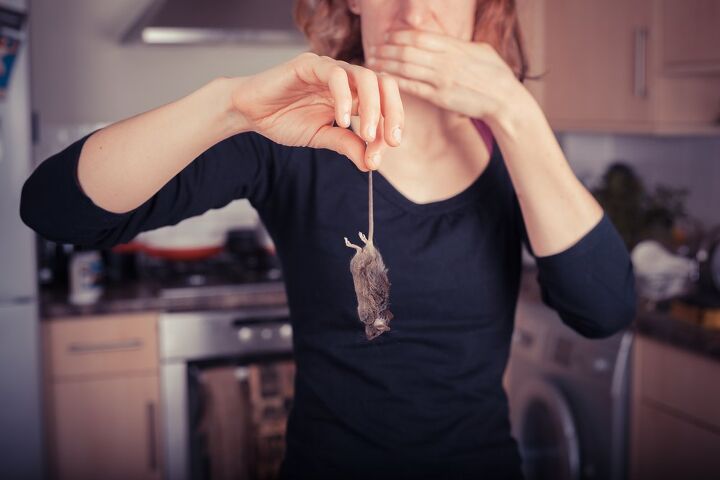Does Cedar Repel Mice? (Find Out Now!)

Not only can mice be a nuisance when found in the home, but they also present a significant health hazard. Their eating habits can quickly result in the spread of disease, contaminating your food. Some individuals may also develop harmful allergic reactions to mice infestations. Identifying the best repellent method is crucial to achieving a mice-free home.
In your search for the best methods to keep mice away from your home, you may come across cedar as a natural method. So, does cedar repel mice? Yes, cedar can repel mice. Cedar’s ability to combat mice stems from its distinctive and pleasant earthy odor. The wood is actually releasing hydrocarbons (phenols) and acids that are essentially natural pesticides. When mice are exposed to cedar, the toxic acids and hydrocarbons are harmful upon inhalation.
With that said, let’s take a deeper look at why cedar repels mice, as well as how to use it and where to place it in order to keep mice away from your home.
Do You Need Pest Control Services?
Get free, zero-commitment quotes from pro contractors near you.

Does Cedar Repel Mice?
Mice are very sensitive to scents, which can be used against them. The scent that cedar emits can make your home undesirable to mice, and hopefully prevent them from even entering in the first place. Cedar, and particularly cedarwood oil, contains effluvium that is known to irritate the rodents. It also has hydrocarbons, like phenols, and acids that are harmful to the mice.
When exposed and under certain conditions, cedar can cause skin irritation and respiratory issues in mice. The toxic phenols get absorbed through their respiratory tract, enter the blood system, and can fatally damage their liver. The acids that cedar released can also cause damage to a mouse’s lungs and trachea. For these reasons, cedar can be an effective natural mice repellent.
Mice rely on their smell to detect harmful foods. When they smell the unfavorable odor of cedar, they will avoid the area and, thus, stay away from your home.
Choosing Cedar to Control Mice
It’s important to note that not all types of wood make effective mice repellents. For best results, Western red cedar mulch, chips, sawdust, and shavings are ideal. This wood is also resistant to moisture so it can stay fresh even in the most wet climates. Opt for fresh, untreated cedar, as stain, paint, and sealants will prevent the phenols that repel mice from releasing.
Whether you choose to use cedar blocks, balls, chips, mulch, or oil doesn’t really matter, as long as it is 100% pure cedar wood. Again, make sure that the product you choose does not have any sort of coating or stain that could prevent the phenols and acids from escaping.
Where to Place Cedar to Deter Mice
In order to figure out the best place to position cedar in your home to deter mice, you need to learn a little bit about mice nesting behavior. For starters, mice are scared of humans. For this reason, they prefer to congregate in shadows and stay hidden. With this in mind, the following places are some of the most common locations that mice tend to nest, hide, and live.
- Garages and attics.
- Areas with a lot of clutter or stored items and a pro-longed absence of human presence.
- Underneath your kitchen cabinets.
- Inside storage boxes that are infrequently inspected or emptied.
- Voids in walls that are insulated and near heat sources.
- Behind large kitchen appliances or inside.
- Inside and underneath furniture.
If you are able to identify where the mice are congregating, you’ll want to position the cedar on the ground in such a way that blocks the entrance to their nesting spot. Typically, potential entrances at ground level and along a wall are the ideal spots to place cedar. Since mice prefer to run along vertical surfaces, they tend to travel up and down walls. It also doesn’t hurt to put some cedar cubes, balls, or chips within the clutter that the mice are nesting in.
How to Use Cedar to Repel Mice
Not only is cedar toxic to mice, its aromatic, woodsy odor is unpleasant to them. How you use cedar to repel mice depends marginally on which product you use.
Cedarwood Oil
Cedarwood oil is one of many essential uses that can be used around the home to make it smell undesirable to rodents. After you obtain cedar oil, you have three options for using it to repel mice: Sprinkling the product directly, spraying it, and soaking cotton balls in the oil and placing them around your house.
1. Sprinkling Cedar Oil
Sprinkling undiluted cedar oil is the easiest application option. However, for best results, you want to be aware of the entry points of the mice. That way, you can spray the undiluted oil directly where they are entering. If you’re unsure, you’ll want to dilute the oil and spray it over a more expansive area.
Simply open the bottle and sprinkle the oil in a widespread manner. While this method may be simple, it typically uses up quite a bit of the repellent which can result in unnecessarily high application costs.
2. Spraying Cedar Oil
After you buy the cedar oil, you can choose to dilute it using either alcohol or distilled water. Place the solution in a spray bottle and spray it near the potential entry routes. Consider spraying your entire home, your garage, outside, and all other mice-infested areas. This option is a more economical choice, as it uses less of the cedar oil.
It can also be used to spray areas that may be infested by other types of pests. Spray the diluted cedar oil on your furniture, carpet, or anywhere else that could benefit from its repellent activity.
3. Soaking Cotton Balls
This method involves soaking cotton balls in the cedarwood oil and then placing them in strategic positions throughout your home. For best results, you always want to soak the cotton balls completely to have the maximum concentration of the oil. After the balls are soaked entirely, place them at the mice’s potential entry points. The smell will be rather strong, so make sure that you place the cotton balls across a relatively large space.
You’ll likely have to regularly soak the cotton balls, as the oil may lose its potency within two hours or so. Though, you can combine the cedar oil with citronella or lemongrass oil to increase the strength of the cedar to longer than two hours.
Note: Although cedar is harmless when used for external purposes, you should avoid any direct contact with your nose, mouth, and eyes. Practice care when applying these oils around children, as internal consumption can cause illness.
Cedar Balls and Wood Chips
If you would rather avoid using messy oils, you can place some dry, cedar balls in vulnerable areas of your home. These balls or blocks of cedar are deodorizing and can be easily found online for purchase. Or, head to a local farm supply store to purchase cedar chips. Place the chips in a pillowcase or cloth bag and then position them at the areas that the mice are entering your home.
However, whether you prefer to use shaped cedar wood or chips, keep in mind that it is just a cloaking mechanism. It most likely won’t make the mice leave your home completely. Instead, you should combine cedar with other methods to get rid of the mice infestation once and for all.
Additionally, the longer than you let the cedar wood sit out, the dryer it will become. Eventually, the strong scent of cedar will dissipate and the wood blocks or chips will need replacing. On average, fresh cedar wood deterrents should be swapped out about every 18 to 24 months.
Do You Need Pest Control Services?
Get free, zero-commitment quotes from pro contractors near you.

Pros and Cons of Using Cedar as Mice Repellent
When used as a mice deterrent, cedar has some benefits and drawbacks. Before you choose to use cedar as a mice repellent, you should consider the following associated pros and cons:
Pros:- Safety – When used responsibly, cedar will not cause illness or affect your home’s indoor air quality.
- A natural repellent – The main benefit of cedar being a natural repellent is the fact that it doesn’t contaminate the environment. Using natural products is a fool-proof way to ensure you and your family’s safety.
- Effectiveness – While it may not eliminate an existing infestation completely, cedar has been tested and proven to repel mice.
- Affordability – When compared to other types of mice repellents, cedar is more affordable. It is also widely available in your local pesticides shop.
- Requires close monitoring – To ensure that the mice don’t return, you’ll need to closely monitor this method. You must constantly re-apply the oils or replace blocks and chips, as the concentration of the cedar will reduce over time.
- Must identify entry points – In order for this method to be effective, you have to know where the mice are coming in. If not, spreading cedar all over your home is not only tedious, but it can get expensive. Identifying potential entry points will save you money and also enhance efficiency.
Related Guide

Jessica considers herself a home improvement and design enthusiast. She grew up surrounded by constant home improvement projects and owes most of what she knows to helping her dad renovate her childhood home. Being a Los Angeles resident, Jessica spends a lot of her time looking for her next DIY project and sharing her love for home design.
More by Jessica Stone



























